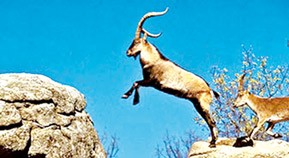Species dying as fast as ever as 2010 conservation target passes
by Ben Webster
 Life on Earth is being extinguished as fast as ever despite a
commitment from world leaders that this year would bring a reduction in
the rate of destruction, a UN study has found. Life on Earth is being extinguished as fast as ever despite a
commitment from world leaders that this year would bring a reduction in
the rate of destruction, a UN study has found.
Mankind's ecological footprint has continued to grow rapidly since
2002 when 190 countries, including Britain, agreed that by 2010 they
would have slowed the rate at which animals and plants were being driven
to extinction.
Only token efforts have been made to preserve species by designating
more national parks and sanctuaries, according to the study by the UN
Environment Programme's World Conservation Monitoring Centre.
The number of animals has fallen by 31 per cent since 1970, living
corals by 38 per cent and mangroves and sea grasses by 19 per cent.
The annual rates of loss have shown no improvement since 2002,
according to the study of more than 40 international monitoring systems.
Several species have died out since the 2010 biodiversity target was
agreed at the 2002 summit in Johannesburg. Within months, the last two
wild Hawaiian crows disappeared, The last Polynesian tree snail died
that year.
 The only known St Helena olive tree died in December 2003 and the
Kihansi spray toad died in the wild in Tanzania in 2005. The main causes
of species loss were all linked to human activities, including habitat
destruction, hunting, the introduction of alien predators, the spreading
of disease and climate change. The only known St Helena olive tree died in December 2003 and the
Kihansi spray toad died in the wild in Tanzania in 2005. The main causes
of species loss were all linked to human activities, including habitat
destruction, hunting, the introduction of alien predators, the spreading
of disease and climate change.
The study also found a rapid increase in the number of endangered
species. The International Union for Conservation of Nature (IUCN)
reported last November that 21 per cent of all known mammals, 30 per
cent of amphibians, 12 per cent of birds and 70 per cent of plants were
under threat. The IUCN calculated that the rate of species loss was up
to 1,000 times greater than the natural background rate.Stuart Butchart,
lead author of the UN study, published in Science, said: "Our synthesis
provides overwhelming evidence that governments have failed to deliver
on the commitments they made and the target has not been met.
We found that the natural world is continuing to be destroyed as fast
as ever.
"Governments have made some efforts, such as designating national
parks, but the responses have been woefully inadequate and the gulf
between the threats to biodiversity and government action is growing
ever wider." He said that there had been some successes, notably the
halving in the rate of destruction of the Amazon since 2004, equivalent
to an area the size of East Anglia being saved each year.
Fight for survival
Extinct species and year of extinction
Kihansi spray toad, 2005
Poo-uli honeycreeper 2004
St. Helena olive 2003
Polynesian tree snail 2002
Hawaiian crow 2002
Pyrenian ibex, 2000
Species that declined badly last year
Rabb's fringe-limbed treefrog (Madagascar)
Eastern voalavo rodent Brown mudfish (New Zealand)
Success stories
Black stilt:
numbers up from 23 to 80
European bison:
now numbers 1,800
-Timesonline |

